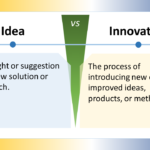Understanding the difference between innovation and idea is crucial for grasping how concepts evolve from thought to implementation.
An idea is a conceptual thought that represents a possible course of action or a mental impression of something.
Innovation involves the practical implementation of ideas into real-world solutions or improvements.

Definition
Innovation
Innovation refers to the process of turning an idea into a new or improved product, service, process, or methodology that adds value or uniquely meets specific needs.
- Characteristics of Innovation:
- Implementation: Requires actual development and practical application.
- Value creation: Must significantly improve something or solve a problem effectively.
- Impact: Often leads to change or progress within a market, community, or society.
Idea
An Idea is the initial conceptualization or a mental representation of a new method, concept, or approach, often not yet tested or realized.
- Characteristics of an Idea:
- Abstract: Exists primarily in the mind and may not have a physical form.
- Potential: Represents potential solutions or creations but lacks concrete form until developed.
- Variability: Can evolve and change rapidly as it is refined or expanded upon.
More Synonyms on innovation, innovate and innovative
Innovation Terms

Innovation is considered as a driving force in progress.
It includes the introduction of novel ideas, methods, or products that bring positive change and advancement.
For more information about innovations, check our glossary
Relation and Relevance
An idea serves as the seed for innovation.
Without innovative thinking, ideas remain as mere concepts without practical application.
Conversely, innovation cannot exist without an initial idea as its foundation. The process of transforming an idea into innovation involves research, development, testing, and refinement.
The key differences between innovation and an idea are:
An idea is a thought or concept that emerges in the mind, often in response to a problem or opportunity. Ideas can be incremental improvements or entirely new concepts.
Innovation, on the other hand, is the successful implementation and commercialization of a new or improved product, service, process, or business model that creates value. Innovation involves taking an idea and turning it into a tangible, impactful outcome, this is also called ideation.
In summary:
- An idea is the initial creative spark, while innovation is the realization of that idea into something new and valuable.
- Ideas are the starting point, but innovation requires developing the idea into a practical solution and bringing it to market.
- Not all ideas lead to successful innovations. Innovation requires additional steps like planning, resource allocation, and execution to turn an idea into a meaningful impact.
- Innovation is about creating something new or improving existing things, while an idea is simply the original thought or concept.
So in essence, an idea is the beginning, while innovation is the end result of successfully developing and implementing that initial idea.
Context for Using Each Term
- Innovation is used in contexts where the focus is on application, practicality, and tangible outcomes, such as in business development, technology, and scientific research.
- Idea is more commonly associated with the creative process, brainstorming sessions, and the early stages of project planning or academic research.
Example of Utilization
The concept of a smartphone was once just an idea—combining the functionality of a phone and a computer into a single portable device. The actual innovation occurred when technology companies successfully developed, produced, and marketed smartphones, radically transforming how we communicate and access information globally.
In summary, while an idea is the starting point of creativity or problem-solving, innovation is the practical execution that brings an idea to life, providing real and impactful solutions in various fields.
FAQ
Q1: Can an idea exist without leading to innovation?
A1: Yes, many ideas remain as concepts and never progress to the stage of innovation due to various factors such as feasibility, resources, or market conditions.
Q2: Is every innovation based on a single idea?
A2: Not necessarily. Many innovations result from combining multiple ideas or building upon existing concepts in new ways.
Q3: Which is more valuable, an idea or an innovation?
A3: While ideas are important, innovations generally hold more tangible value as they represent ideas that have been developed and implemented to create practical solutions or products.
Q4: Can innovation occur without a preceding idea?
A4: Innovation typically starts with an idea, even if that idea is not fully formed. However, some innovations may evolve through experimentation or serendipitous discoveries.
- Falcony Blog - Idea, Initiative, Innovation: The Difference
- LinkedIn - Ideas vs Invention vs Innovation
- IdeaNote Blog - Definition of Idea, Innovation, and Many More
- Assembly Blog - Differences Between Idea Management and Innovation Management
- Idea to Value - What Is the Difference Between Innovation, Invention, and an Idea?

